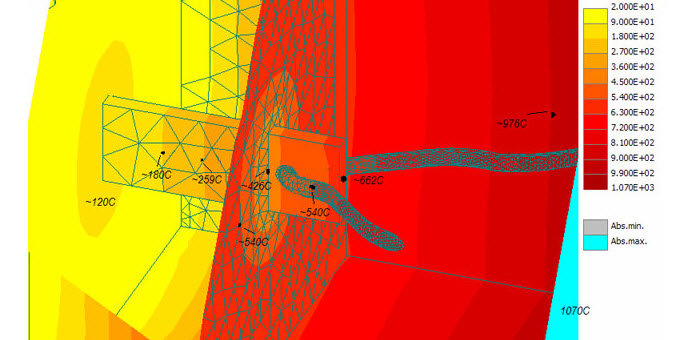A Primer on the Basic Physical Properties of a Refractory Product
 A refractory’s physical properties are listed on its data sheet and provide an indication of how the refractory should perform under different operating conditions. While technical data sheets should never be considered as the only basis for selecting refractory, the refractory’s physical makeup is an important element to consider. Let’s take a look at the properties:
A refractory’s physical properties are listed on its data sheet and provide an indication of how the refractory should perform under different operating conditions. While technical data sheets should never be considered as the only basis for selecting refractory, the refractory’s physical makeup is an important element to consider. Let’s take a look at the properties:
1. Bulk Density
The Bulk Density of a refractory is the ratio of weight (or mass) to volume. It’s expressed in pounds per cubic foot (lb/ft2) or kilograms per cubic meter (g/cm3).
2. Cold Crushing Strength
Often referred to as CCS, Cold Crushing Strength measures the maximum stress needed to crush a refractory sample to structural failure in compressive loading. CCS is measured, according to ASTM C133, on typically a 2” cube. Cold crushing strength of a refractory material is an indication of its suitability for use in refractory construction. (It is not a measure of performance at elevated temperature.) CCS measures the mechanical strength at room temperature. It is not indicative of mechanical strength at operating temperature. Also, high CCS values don’t necessarily translate to better resistance to load deformation.
3. Modulus of Rupture (MOR)
The MOR indicates the refractory’s tensile strength, that is, MOR evaluates failure with the loading in tension. It is determined by supporting a refractory across a span and using a testing maching to apply load at a specified rate until the refracotry breaks. It’s calculated at room temperature. A higher temperature calculation is called a hot modulus of rupture.
4. Apparent Porosity
Apparent porosity in a refractory is reported as a “percentage apparent porosity” that represents the volume fraction of pores present. A higher porosity refractory will typically have excellent insulating properties but a lower strength, density and resistance to corrosion. A lower porosity refractory will typically be stronger, with less resistance to corrosion, but it can lower the thermal shock resistance.
5. Thermal Shock Resistance
A refractory typically endures rapid and extreme temperature changes. These fluctuations create thermal stresses within the refractory that can cause rapid expansion or contraction of a section of the material. There are two common tests used to measure thermal shock resistance: the loss of strength test and the prism spalling test.
In the loss of strength test, a sample is cycled five times from room temperature to 2200 degrees F. MOR is then performed on both cycled and uncycled specimens, and the “percent loss of strength” is calculated by subtracting the MOR of the cycled sample from that of the uncycled sample. This test is repeated on an average of 5 specimens. The lower the percent loss of strength, the better the thermal shock resistance.
In the prism spalling test, refractory samples are cycled from 2200 degrees F for 10 minutes, to water for 2 minutes, to air for 8 minutes, until the samples have broken or have undergone 40 cycles. The higher the number of cycles, the better the material’s thermal shock resistance is.
Be sure to only compare data from the same test method.
6. Reversible Thermal Expansion and Permanent Linear Change
A refractory will expand when heated and contract when cooled. Most data sheets contain a thermal expansion curve graph, which depicts the expansion rate at specific temperatures. Different materials expand at different rates. When cooled, the refractory could end up larger or smaller than the original dimension. Reheat tests for each class of refractory will display the permanent linear and volume change.
7. Thermal Conductivity
This is a measurement of the amount of heat which flows from the hot face to the cold face of a refractory lining. The heat flow is inversely proportional to the thickness of the wall, and is directly proportional to the conductivity value of the refractory, the temperature drop from the hot face to the cold face, the area of the wall, and time.
There are several different methods for measuring thermal conductivity, so make sure to compare the results of the same test methods during a comparison.
Standard load tests place a refractory in a furnace with a load applied, which is then heated and cooled. The new sample is measured and compared to the dimensions of the original sample.
8. Abrasion Resistance
It’s common for a refractory to be exposed to moving materials in a furnace, including abrasive dusts and rapidly moving gases. Strong and well-bonded materials provide the greatest resistance to abrasion. The most common method of measuring abrasion resistance subjects a refractory to an impinging stream of silicon carbide grain, with the volume loss measured after the test and expressed as volume (cc) loss. Again, only compare abrasion resistance from the same testing method.
Data Sheets Are Just One Piece of the Puzzle
The content of this post is geared toward those interested in technical details. Just be sure to remember that data sheets are only one part of the “big picture” that you need to consider when selecting refractory material. There are many other variables about your particular project and environment that are just as crucial to the final selection. We’d love to share our years of experience with you, so give us a call if you’d like our input.
Comments are closed.

